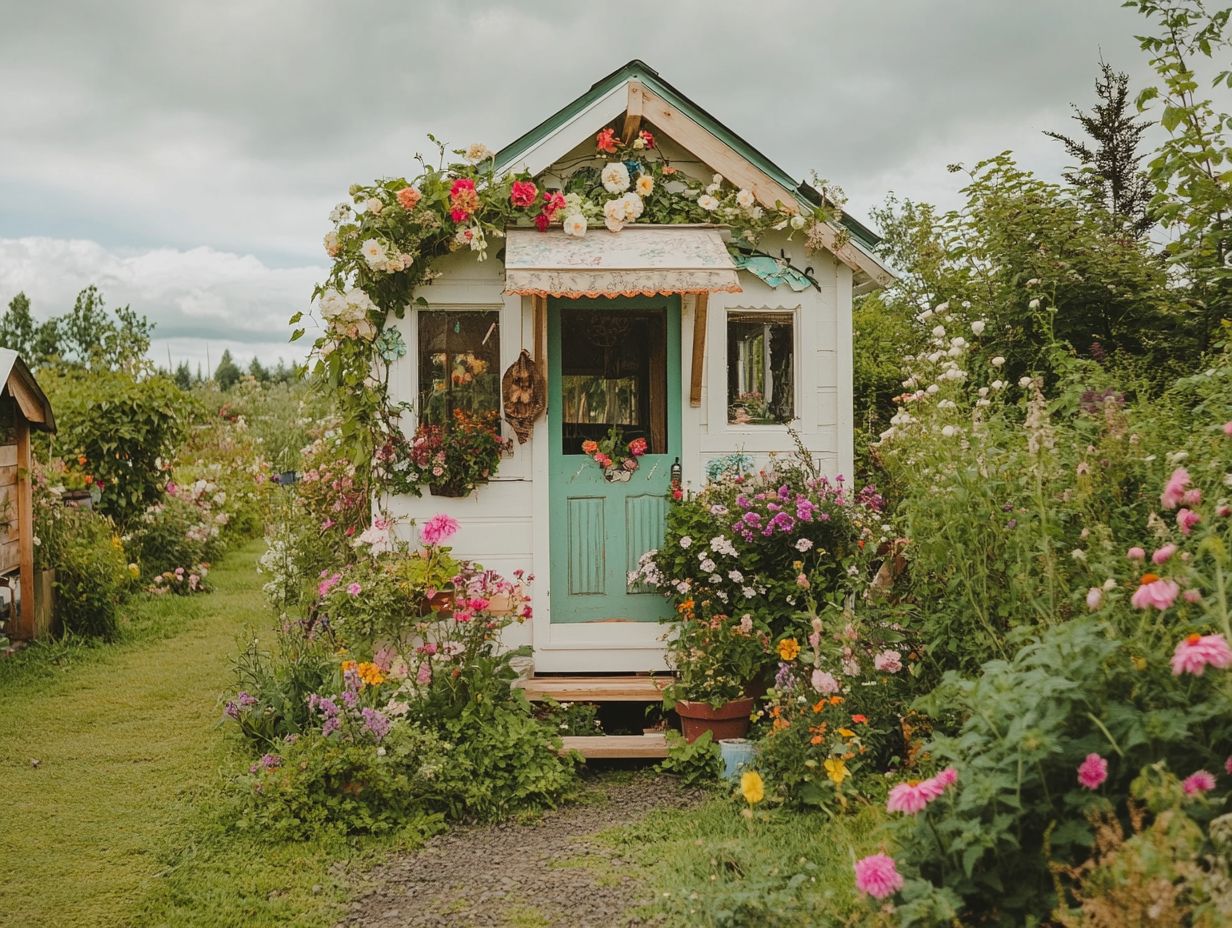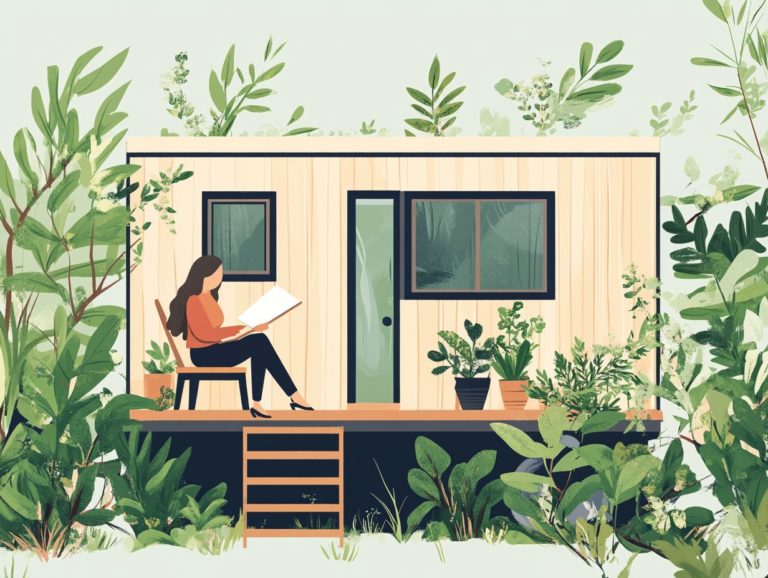Best Practices for Tiny House Legal Compliance
Navigating the captivating realm of tiny houses is undeniably exhilarating. However, it demands a keen awareness of legal compliance.
Whether you re envisioning a life of downsizing or fully committing to a minimalist lifestyle, understanding building codes, zoning regulations, permits, and insurance is urgent don’t risk fines or relocation!
This guide helps you navigate the essential legal rules for tiny houses, ensuring you can build your dream home without a hitch!
Explore the best practices that will empower you to craft your tiny home in both a legal and safe manner.
Contents [hide]
- Key Takeaways:
- Understanding Legal Compliance for Tiny Houses
- Building Codes for Tiny Houses
- Zoning Laws and Regulations
- Permits and Inspections
- Types of Permits Needed for Tiny Houses
- Insurance for Tiny Houses
- Frequently Asked Questions
- What are the best practices for complying with laws and regulations when building a tiny house?
- Do I need a specific type of foundation for my tiny house?
- Are there size limitations for a tiny house?
- Can I live in a tiny house full-time?
- What are the consequences of not complying with legal requirements?
- What safety regulations do I need to follow when building a tiny house?
Key Takeaways:

- Understanding legal compliance is crucial for anyone building or living in a tiny house, as failure to comply can result in fines or even being forced to relocate.
- Building codes for tiny houses may vary by location, but they generally require adherence to safety and construction standards.
- Zoning laws and regulations also play a role in the legality of tiny houses, and it is important to research and follow these laws to avoid any legal issues.
Understanding Legal Compliance for Tiny Houses
Navigating legal compliance for tiny houses is crucial for you as a tiny homeowner or enthusiast eager to partake in the Tiny House Movement while respecting local laws and regulations. This journey entails a deep understanding of the details of tiny house laws and regulations that can vary significantly from one jurisdiction to another.
Familiarize yourself with zoning regulations and building codes enforced by local municipalities. Your rights and responsibilities as a tiny house owner hinge on following these legal frameworks, ensuring that your tiny home, whether it’s on wheels or a solid foundation, meets the specific requirements set forth by local planning commissions and zoning departments.
What is Legal Compliance?
Legal compliance is all about following the laws, regulations, and guidelines established by governing bodies. It s especially significant for tiny houses due to their unique structures and living situations.
For you, as a tiny house owner, understanding the details of legal compliance is essential. It directly influences where you can live and how you can build your home. Building codes, which outline safety standards and construction practices, along with zoning regulations that dictate land usage, are important parts of following these laws. Additionally, incorporating sustainable design practices for tiny houses can enhance your living experience. Take Portland, Oregon, and Austin, Texas, for example; these municipalities have recognized the charm of tiny homes and crafted specific regulations to accommodate them.
In these forward-thinking areas, tiny houses on wheels are embraced as a legitimate housing option, showcasing a growing acceptance of alternative living arrangements while ensuring that safety and community standards are upheld. Furthermore, many of these communities implement sustainable practices to enhance their environmental impact.
Building Codes for Tiny Houses
Building codes for tiny houses are essential in guaranteeing both safety and functionality in these compact living spaces. These regulations are based on standards like the International Building Code (IBC) and the International Residential Code (IRC).
Whether you’re considering a tiny house on wheels or one anchored to a foundation, these codes outline important requirements, such as minimum ceiling height, emergency exit points, and the need for a dedicated bathroom. To ensure compliance for various housing forms, including accessory dwelling units (ADUs), it’s beneficial to explore navigating tiny house community regulations, allowing you to create a space that is not only charming but also meets essential safety standards.
Overview of Building Codes
Building codes, particularly the International Building Code (IBC), lay out essential safety standards that your tiny house must meet to ensure the well-being of everyone inside. These regulations cover various construction aspects, including structural integrity, fire safety, electrical systems, and plumbing.
If you’re considering tiny house living, adhering to these codes is vital. Not only does it promote safety, but it also improves the quality of where you live. For more information, exploring the legalities of tiny house communities can help you understand the regulations involved. Compliance with building codes ensures that your tiny home can stand strong against environmental challenges, like severe weather conditions.
These standards also create a framework for sustainable practices, prioritizing energy efficiency and resource conservation key elements for anyone embracing the tiny house movement.
Specific Requirements for Tiny Houses

When considering tiny houses, you ll encounter specific requirements. These include minimum ceiling height, mandatory emergency exit points, and a separate bathroom for building code compliance.
These regulations are vital for your safety and legal compliance. For instance, many areas require a minimum ceiling height of 7 feet for proper ventilation and to avoid a claustrophobic feeling.
You usually need at least two emergency exit points to meet fire safety standards. Additionally, a separate bathroom not only meets plumbing standards but enhances your overall living experience.
By following these standards, you can enjoy your tiny home without worrying about legal issues or safety concerns.
Zoning Laws and Regulations
Zoning laws dictate where tiny houses can be placed. You must navigate these local ordinances carefully.
In many areas, especially those embracing tiny living, these laws clarify if your tiny home can sit on a permanent foundation or must be a mobile unit on wheels.
Local zoning departments are key players in enforcing these regulations. Their guidance is essential for your housing journey.
Zoning Laws for Tiny Houses
Zoning laws for tiny houses vary by municipality. Sometimes, a land use attorney is needed to navigate these complex regulations.
These rules can dictate everything from minimum square footage to specific land use designations. For example, some areas allow tiny homes on wheels as temporary dwellings, while others classify them as permanent residences.
In places like California and Oregon, innovative zoning overlays encourage tiny housing communities. In busy cities like New York and Los Angeles, you may face various challenges that can slow down builders.
Understanding these zoning laws is key for compliance and tackling challenges in your tiny house development journey.
How to Comply with Zoning Regulations
To comply with zoning regulations, thoroughly explore local laws. You may need to submit your plans to the local zoning department for approval.
Specific zoning requirements can vary widely. Investigate your municipality’s comprehensive plan and land-use policies.
This involves identifying your property s zoning category and understanding unique local ordinances like setback requirements and minimum square footage regulations.
Community resources, like local builders or zoning workshops, can provide valuable insights. Engaging with neighbors and planners can foster goodwill and ease the approval process.
Permits and Inspections
Permits and inspections are crucial in the legal journey of tiny houses. They ensure construction and placement meet local building codes and zoning regulations.
By navigating this process diligently, you can align your tiny house with legal standards and community expectations.
Types of Permits Needed for Tiny Houses

You’ll likely need several permits for tiny houses, including building permits and zoning permits. Depending on your location and tiny home’s specific design, you might also need additional licenses.
Knowing about these permits can make your tiny home dream a reality! Building permits ensure your structure meets safety codes. Meanwhile, zoning permits confirm that your intended land use aligns with local laws.
In some cases, you may need permits related to utilities, such as septic systems and water connections. This emphasizes the need for thorough research.
Start by consulting your local planning department. They can provide valuable guidance on specific requirements and processes unique to your area.
Importance of Inspections
Inspections are vital for ensuring your tiny house complies with building codes and zoning regulations. They protect the health and safety of everyone inside.
These evaluations help identify potential issues, such as structural weaknesses, plumbing problems, or electrical hazards. If you’re considering the tiny house lifestyle, passing inspections is critical not just for legal compliance but also for your peace of mind.
Keep all documentation organized, including permits and floor plans, to make the inspection process smooth.
Prioritize hiring licensed professionals for vital tasks like electrical and plumbing work. This ensures every element meets safety standards, creating a secure and livable environment that enhances your tiny home experience.
Insurance for Tiny Houses
Insurance is an important thing to think about as a tiny homeowner. It offers a range of coverage options designed to protect against the unique risks of living in a compact, mobile space.
Types of Insurance Coverage
- Comprehensive coverage
- Personal property coverage
- Liability coverage
Comprehensive coverage protects against various risks think fire, theft, and severe weather damage. This ensures you can bounce back from unforeseen events with confidence.
Personal property coverage safeguards the items in your tiny home, from your beloved electronics to your cherished furniture, preserving your investment.
Liability coverage shields you from legal claims arising from accidents on your property, providing financial security if a lawsuit occurs. Together, these options form a robust safety net, giving you the power to embrace your tiny house lifestyle with greater peace of mind.
How to Obtain Insurance for a Tiny House
To secure insurance for your tiny house, connect with local insurance agents who specialize in tiny house policies. This ensures you get the right coverage for your needs.
These professionals can offer personalized guidance tailored to the intricacies of tiny living, considering factors like mobility and construction materials. When assessing policies, seek coverage that encompasses personal liability, property damage, and protection against natural disasters.
Understanding the differences between full-time and part-time residency can influence your premiums and available coverage options. Collaborating with knowledgeable agents experienced in tiny house insurance allows you to navigate these policies confidently, ensuring your investment is well protected.
Check out the video above for more insights on tiny house living and insurance options!
Frequently Asked Questions

Contact a local insurance agent today to get started on protecting your tiny home!
What are the best practices for complying with laws and regulations when building a tiny house?
To build a tiny house legally, research your local zoning laws and building codes. Obtain the necessary permits and work with licensed professionals to ensure compliance.
Do I need a specific type of foundation for my tiny house?
The required foundation for your tiny house depends on your location. Consult a licensed professional to find out what works best for you!
Are there size limitations for a tiny house?
Size limitations for tiny houses can vary by location. Some places may have minimum or maximum square footage rules, so it s crucial to understand your local regulations.
Can I live in a tiny house full-time?
Living in a tiny house full-time depends on local zoning laws. In some areas, tiny houses are allowed as permanent residences, while in others, they may only be permitted for temporary use.
What are the consequences of not complying with legal requirements?
Failing to comply with legal standards for a tiny house can lead to serious consequences. You might face fines, stop-work orders, or even the demolition of your house, so follow the rules!
What safety regulations do I need to follow when building a tiny house?
Safety regulations include fire safety, electrical wiring, and plumbing requirements. Always work with licensed professionals who understand these safety standards!






